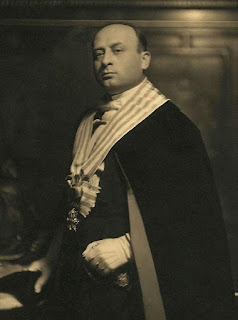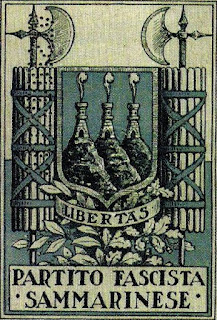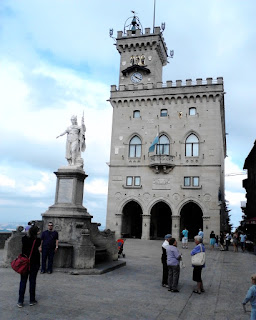The 'last gentleman racer' of Formula One
 |
| Elio de Angelis drove for Lotus for six seasons |
The Formula One motor racing driver Elio de Angelis was born on this day in 1958 in Rome.
His record of winning two Grands Prix from 108 career starts in F1 may not look impressive but he was regarded as a talented driver among his peers, holding down a place with Lotus for six consecutive seasons alongside of such talents as
Nigel Mansell and
Ayrton Senna, both future world champions.
He had his best seasons in 1984 and 1985, which encompassed seven of his nine career podium finishes and in which he finished third and fifth respectively in the drivers' championship standings.
Tragically, he was killed in testing the following year, having left Lotus for Brabham in frustration after perceiving that Senna was being given more favourable treatment.
De Angelis was seen by many in motor racing as "the last of the gentlemen racers."
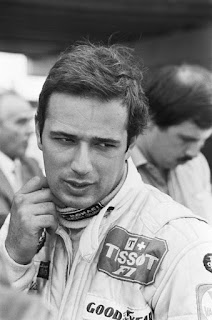 |
De Angelis hailed from a wealthy
background in Rome |
In contrast to his teammate Mansell, who came from a working class background in the West Midlands of England, De Angelis was born into wealth.
His family was long established in the upper echelons of Roman society. His father,
Giulio, ran a successful construction company and raced powerboats, winning many championships in the 1960s and 1970s. Elio was the oldest of his four children.
This glittering pedigree had its disadvantages. Elio was known to be on the target list for
Red Brigades kidnappers and when he returned to Rome to visit his parents he was whisked from the airport in a bulletproof limousine and could not step out even for a pizza without two bodyguards for company.
On the other hand, he was free to indulge himself in whatever entertainment took his fancy. He skied and played tennis and showed a talent for both, as he did for the piano, which he learned to concert standard. Perhaps through his father's genes, he also loved speed.
He started karting when he was 14, finishing second in the World Championship in 1975 and winning the European title in 1976.
By the age of 19 he was driving in Formula Three, winning his first race on only his third start at the
Mugello circuit near Florence. He then went on to win the Italian Formula Three Championship in 1977.
In 1978 he raced in Formula Two as well as Formula Three, in which his victory in the prestigious Monaco F3 race. That led to a chance to test for the Shadow F1 team.
Ultimately, his father paid for him to race for Shadow, which was not good for Elio's reputation at the start. Yet his talent shone through and won his respect.
 |
| De Angelis in action for Lotus in 1985 |
It also led him to being hired by Colin Chapman to drive for Lotus in 1980 and when, in only his second race, the 21-year-old Elio failed narrowly to become the youngest winner of a Formula One race when he finished second to René Arnoux in Brazil it was clear he was a star in the making.
Off the track he was both envied and admired. He had style in abundance and any resentment of his privileged background was soon overcome by his easy charm. He was friendly and respectful towards the other drivers but could also join in the jokes. And such was his natural talent that he could turn up at the last minute for a qualifying session, sometimes so disorganised he might have to borrow a helmet from another driver, yet still set the fastest lap time.
His first victory came in the Austrian Grand Prix in 1982 and he finished ahead of Mansell in the drivers' standings all but the 1983 season, when his car was plagued by mechanical problems.
The 1985 season brought a second Grand Prix victory for De Angelis at
San Marino after Alain Prost took the chequered flag first but was subsequently disqualified for an underweight car. However, the arrival of Senna in place of Mansell, who had gone to Williams, marked a change in fortunes for the Italian.
Senna finished fourth to his fifth in the drivers' championship, despite De Angelis maintaining the consistency he and his car had shown in 1984, and when Lotus appeared to be concentrating their resources and expertise on the Brazilian driver De Angelis began to look elsewhere.
His move to Brabham seemed full of promise, giving him the chance to drive the BT55, a new low-frame chassis car designed to create less drag. After only four races, however, during testing at the Paul Ricard circuit in France, De Angelis's BT55 lost its rear wing at high speed, catapulted over a barrier and caught fire.
The driver's physical injuries were minor but he was unable to escape from the car unaided. He died just over a day later from the affects of smoke inhalation. The lack of qualified track marshalls on hand, combined with a delay in the arrival of a helicopter to take him to hospital, were said to have contributed to his death.
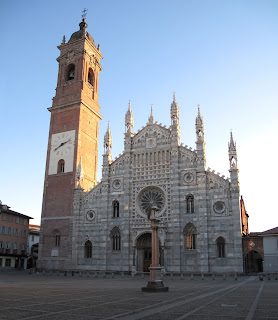 |
| Monza's Duomo, with its white and green facade |
Travel tip:
Formula One motor racing in Italy is about
Monza, which has hosted the Italian Grand Prix every year since 1950. The city itself - situated about 15km (9 miles) north of Milan - is underappreciated. It has several notable architectural attractions, including the Gothic
Duomo, with its white-and-green banded facade, which contain the Corona Ferrea (Iron Crown), which according to legend features one of the nails from the Crucifixion. The crown is on show in the chapel dedicated to the Lombard queen Theodolinda. The adjoining Museo e Tesoro del Duomo contains one of the greatest collections of religious art in Europe.
TripAdvisor's lowdown on the best hotels in Monza
 |
| The view across Rome from Monte Mario |
Travel tip:
There are many ways of enjoying Rome, but to appreciate the city in its full perspective, the
Monte Mario natural park offers breathtaking views. Situated to the west of the city, it is the highest point of Rome and it is possible to pick out almost every notable dome and bell tower. The most popular panoramic terrace, called Zodiaco, is near the astronomical observatory.
Hotels in Rome by Booking.com
More reading:
How Michele Alboreto almost ended Italy's long F1 drought
Vittorio Grigolo - the singer who chose opera over F1
Luigi Fagioli - still F1's oldest winning driver
